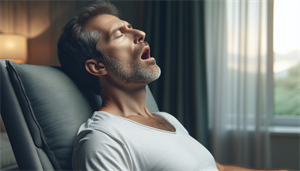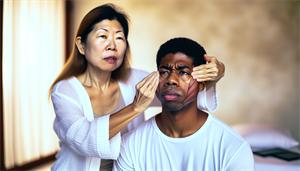Imagine being able to manage your sleep apnea, a condition that affects millions of people around the world, with just a few simple exercises for sleep apnea. Intriguing, right? Sleep apnea doesn’t just rob you of your sleep, but also your energy, productivity, and overall well-being.
But there’s a silver lining: by incorporating these simple exercises for sleep apnea into your daily routine, you can significantly alleviate sleep apnea symptoms and reclaim your life!
Key Takeaways
-
Regularly practicing throat exercises, vocal vowel workouts, and specific techniques like the Yawn and Hold can strengthen muscles around the airway, potentially reducing snoring and symptoms of mild to moderate obstructive sleep apnea.
-
Tongue toning exercises including the Entire Tongue Lift, Progressive Tongue Stretch, and Dynamic Tongue Pushes help in toning the tongue and surrounding muscles, possibly alleviating airway obstructions and improving sleep apnea-related breathing issues.
-
Integrating diverse exercises such as diaphragmatic breathing, myofunctional therapy, and cardiovascular activities along with positional adjustments and CPAP therapy, if applicable, can provide comprehensive management of sleep apnea.
Unlocking the Power of Throat Strengthening

We begin our quest for improved sleep by harnessing the power of throat exercises. Strengthening the muscles around the airway can lead to reduced snoring and improved airway stability, effectively managing mild to moderate obstructive sleep apnea.
Imagine having the power to counteract airway blockage during sleep! Sounds amazing, doesn’t it? We’ll delve into this topic to understand the benefits of throat strengthening.
Vocal Vowel Workouts
Vocal vowel workouts are a key tool in your arsenal against sleep apnea. Regular practice of vocal vowel sounds can fortify your throat muscles, resulting in reduced snoring and potential relief from sleep apnea symptoms.
Repetition of vowel sounds allows for specific targeting and strengthening of throat muscles, crucial for maintaining an open airway during sleep. So, are you ready to turn vowels into your secret weapon against sleep apnea?
The Yawn and Hold Technique
Next in line is the amazing Yawn and Hold technique. It’s all about strengthening mouth and throat muscles to reduce sleep apnea symptoms. In this technique, you’ll tilt your head back, open your mouth wide, and take deep breaths through your mouth. It sounds simple, but this exercise has the power to strengthen your throat and mouth muscles, prevent tissue collapse in the airway, and enhance overall sleep quality, all of which contribute to reducing sleep apnea symptoms.
Get ready to elevate your breathing technique with the Yawn and Hold Technique.
Soft Palate Elevations
Now, let’s turn the spotlight to soft palate elevations. By engaging the muscles in the mouth and throat, strengthening the soft palate through training can lead to improved symptoms of obstructive sleep apnea and a reduction in snoring. This is achieved by performing simple stretches and ‘soft palate pushups’ using specific sounds.
With these exercises, you can enjoy the benefits of a stronger soft palate, which plays a crucial role in causing airway obstruction during sleep.
Tongue Toning Tactics for Sleep Apnea
Advancing to tongue toning tactics, further fortification against sleep apnea is possible. Tongue exercises are the key to toning and strengthening the muscles in the tongue and surrounding areas, which in turn reduces airway obstructions during sleep, helping you breathe easier and sleep better.
From the Entire Tongue Lift to the Progressive Tongue Stretch and Dynamic Tongue Pushes, let’s explore how these techniques can help in managing sleep apnea.
The Entire Tongue Lift
The Entire Tongue Lift technique is a powerful tongue workout. It involves:
-
Lifting your entire tongue towards the roof of your mouth
-
Using the muscles at the back of your tongue
-
Targeting and strengthening the tongue muscles and the hyoid muscles.
Incorporation of a tongue lift into your routine can fortify your tongue and throat muscles, resulting in enhanced muscle tone in the mouth, throat, and soft palate. Get ready to transform your tongue strength with the entire tongue lift exercise.
Progressive Tongue Stretch
Next is the Progressive Tongue Stretch. This exercise targets the tongue muscles, improving their strength and flexibility. Just stick out your tongue as far as possible until you feel a stretch and hold this position for 10 seconds.
This simple yet effective exercise can make a substantial difference in your battle against sleep apnea. So, are you ready to stretch your way to better sleep?
Dynamic Tongue Pushes
The final tongue toning tactic is the Dynamic Tongue Pushes. This technique involves pushing the tongue against resistance, which strengthens tongue muscles and effectively reduces sleep apnea symptoms. With this technique, you can improve tongue posture, prevent it from relaxing and curling backward towards the throat, which is a common cause of airway obstructions in sleep apnea sufferers.
It’s time to push your way to better sleep with dynamic tongue pushes.
Breathing Exercises: The Path to Better Sleep

We now delve into the realm of breathing exercises. Breathing exercises have been shown to improve sleep apnea symptoms by strengthening respiratory muscles and promoting efficient breathing.
From mastering diaphragmatic breathing to enhancing nasal breathing, let’s explore how these exercises can pave the way to better sleep.
Diaphragmatic Breathing Mastery
Diaphragmatic breathing is a powerful technique that involves using the diaphragm to breathe deeply and fully. Not only does it strengthen the diaphragm and improve respiratory function, it also promotes relaxation and reduces stress, leading to better sleep quality for individuals with sleep apnea.
Mastering diaphragmatic breathing enhances diaphragm muscle strength, improves breathing efficiency, and promotes better body oxygenation. Are you ready to breathe your way to better sleep?
Nasal Passage Patience
Next, let’s talk about the importance of nasal breathing for those with sleep apnea. Nasal breathing is crucial as it stabilizes the airway during sleep, promoting a restful and rejuvenating night’s sleep. By focusing on exercises that enhance nasal breathing, you can train your body to switch from mouth to nasal breathing, effectively reducing sleep apnea complications.
Ready to breathe easy and sleep soundly?
Facial Fitness to Fight Sleep Apnea

Facial fitness exercises have a substantial impact on sleep apnea management. Strengthening facial muscles can help improve sleep apnea symptoms, especially in mild cases.
From the Cheek Hook and Pull to Fish Face Formations, let’s discover how these exercises can help you fight off sleep apnea.
Cheek Hook and Pull
The Cheek Hook and Pull exercise targets cheek muscles, promoting a closed mouth during sleep and reducing snoring. This technique involves using a hooked finger to lightly pull your cheek outward while using your facial muscles to pull your cheek further outward.
Regular practice of this exercise can lead to stronger cheek muscles and better management of sleep apnea.
Fish Face Formations
Next is the Fish Face exercise. This exercise works mouth, cheek, jaw, and tongue muscles and could potentially reduce sleep apnea symptoms.
By simply puffing out your cheeks and pursing your lips, you are working your facial muscles and aiding in sleep apnea management.
Comprehensive Physical Exercise for Sleep Apnea Management

Physical exercises have a pivotal role in managing sleep apnea. Regular physical activities, particularly cardiovascular exercises, can improve your sleep quality and decrease the occurrence of sleep apnea episodes.
We’ll examine how exercises, ranging from low-impact starters to cardiovascular commitments, can assist in managing sleep apnea.
Low-Impact Starters
Low-impact exercises like walking and swimming are a great way to start a more active lifestyle while managing sleep apnea. These exercises are gentle on your joints yet effective in improving cardiovascular health and reducing the severity of sleep apnea symptoms.
Cardiovascular Commitments
Cardiovascular exercises such as running, cycling, and swimming can also significantly improve heart health and reduce sleep apnea severity. By strengthening your heart and lungs, these exercises can help manage sleep apnea more effectively.
So, are you ready to make a cardiovascular commitment for better sleep?
Myofunctional Therapy Insights
Myofunctional therapy presents another potent tool in sleep apnea management. It involves a set of mouth and throat exercises that can improve muscle strength and reduce snoring and sleep apnea symptoms.
We’ll delve into the fundamentals of myofunctional therapy and the integration of myofunctional exercises to understand how this therapy assists in sleep apnea management.
Fundamentals of Myofunctional Therapy
Myofunctional therapy targets improper function of tongue and facial muscles. By embracing the key principles of this therapy, you can train your facial and mouth muscles to work more effectively. This therapy also focuses on promoting nasal breathing, proper tongue posture, and correct swallowing patterns, leading to improved muscle function and overall better management of sleep apnea.
Integrating Myofunctional Exercises
Incorporating myofunctional exercises into your daily routine can help improve sleep apnea symptoms and overall sleep quality. These exercises strengthen the muscles around the airway, including the tongue, face, and mouth, improving muscle tone and alleviating upper airway collapse.
From tongue push-ups to practicing breathing through the nose, these mouth exercises can pave the way for better sleep and increased energy throughout the day.
Alternative Approaches and Supportive Strategies
It is equally important to combine sleep apnea exercises with other treatments and supportive strategies. From positional adjustments for better sleep to combining exercises with CPAP therapy, these alternative approaches can help manage sleep apnea more effectively.
We’ll delve into these strategies with greater detail.
Positional Adjustments for Better Sleep
Adjusting your sleep position can have a significant impact on managing sleep apnea. The supine or back sleeping position can worsen sleep apnea due to gravity pulling the airway muscles back. On the other hand, the lateral or side sleeping position can minimize snoring and enhance symptoms of sleep apnea by allowing for a more open airway.
Additionally, elevating your head can also enhance airflow and decrease the severity of sleep apnea.
Combining with CPAP Therapy
Combining CPAP therapy with sleep apnea exercises can give you a comprehensive approach to managing sleep apnea symptoms. Here are the steps to follow:
-
Start with CPAP therapy, which uses a machine to keep your airways open.
-
Incorporate sleep apnea exercises into your routine to strengthen breathing muscles.
-
Practice these exercises regularly to enhance your treatment and experience better results.
By following these steps, you can effectively treat sleep apnea, manage your sleep apnea symptoms, and address sleep disordered breathing.
Summary
In summary, managing sleep apnea does not have to be an uphill battle. With the right exercises and supportive strategies, you can significantly improve your sleep quality and overall well-being. From throat strengthening to tongue toning, from breathing exercises to facial fitness, and from physical exercises to myofunctional therapy, every step you take towards incorporating these techniques into your daily life can make a vast difference in managing sleep apnea. So, are you ready to take control of your sleep and embrace a healthier, happier life?
Frequently Asked Questions
Can you fix sleep apnea with exercise?
Absolutely, regular aerobic exercise has been shown to significantly improve sleep apnea. Studies indicate that exercise can lead to major benefits for sleep apnea patients, including reducing body weight and severity of the condition.
What is the best breathing exercise for sleep apnea?
The best breathing exercise for sleep apnea is diaphragmatic breathing. It helps improve airflow and reduce the severity of sleep apnea. Practice it regularly for better sleep.
What positions reduce sleep apnea?
Sleeping on your side can help keep your airways open and reduce snoring and mild sleep apnea by preventing obstructions, while sleeping on your back may block your airways.
Symptoms of sleep apnea?
If you notice warning signs like loud snoring and daytime fatigue, it's important to consider the possibility of obstructive sleep apnea. Seek medical advice for a proper diagnosis and treatment.
What is myofunctional therapy and how can it help with managing sleep apnea?
Myofunctional therapy can help manage sleep apnea by improving muscle strength in the mouth and throat, ultimately reducing snoring and sleep apnea symptoms. Give it a try!


